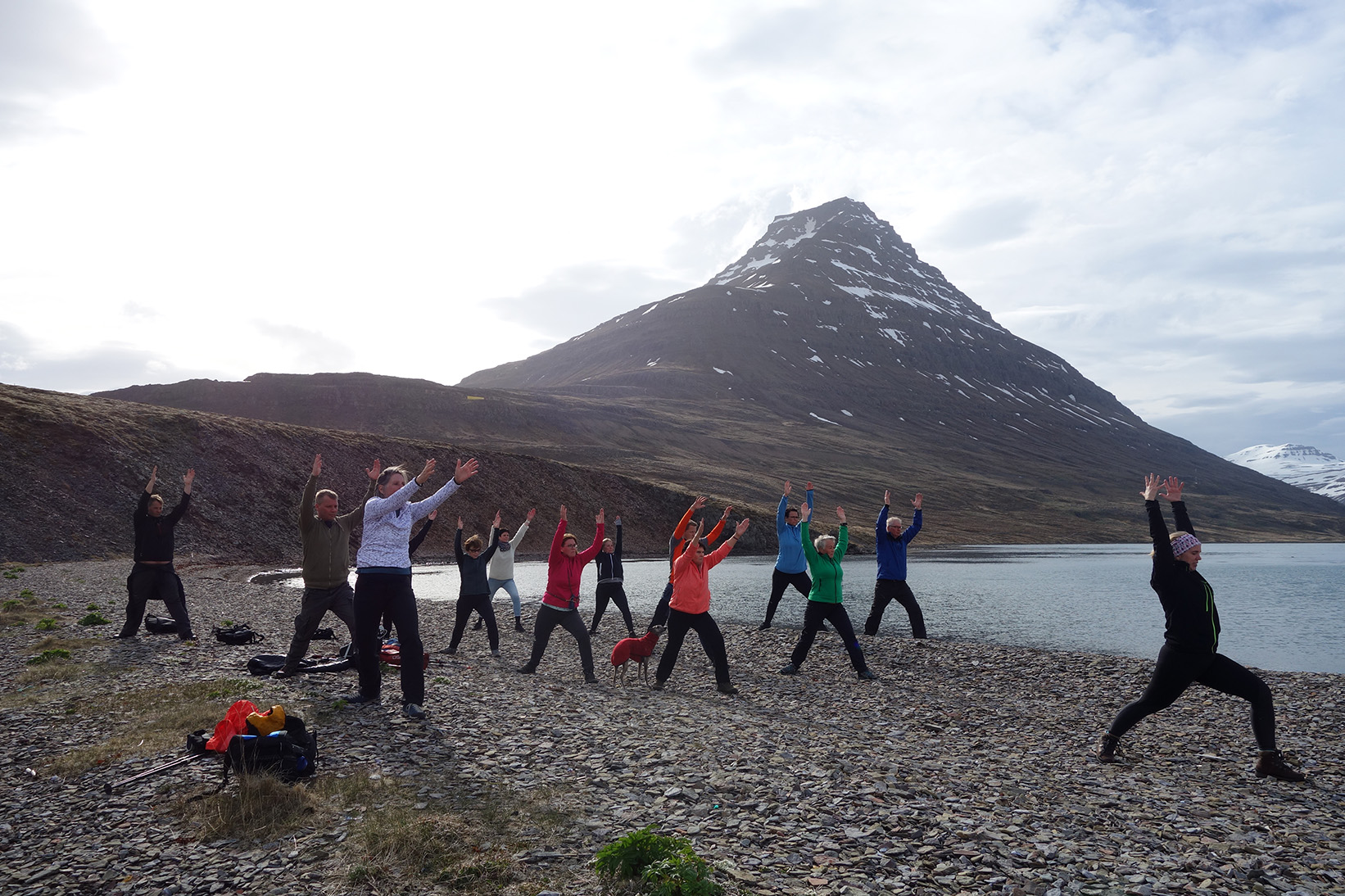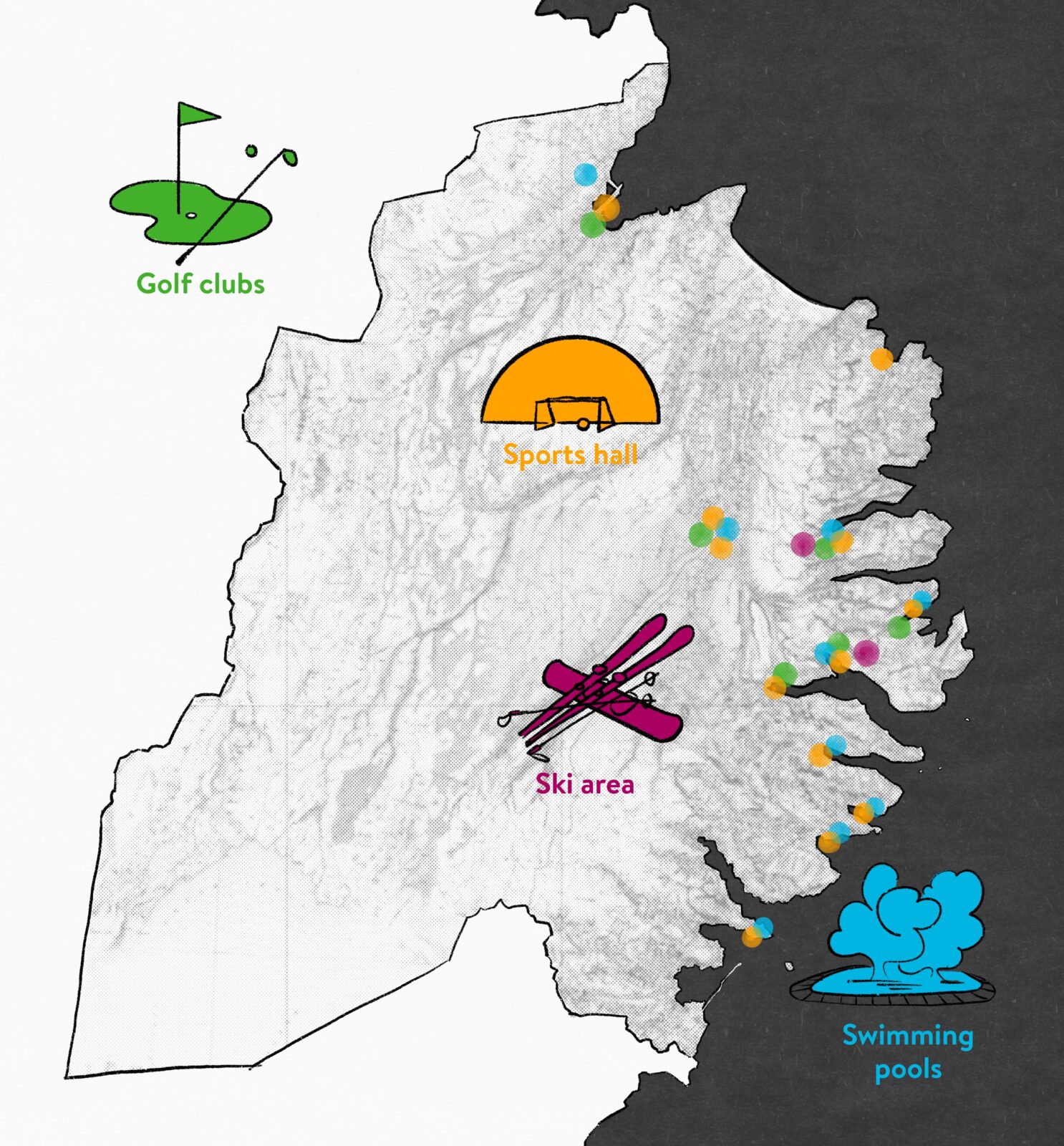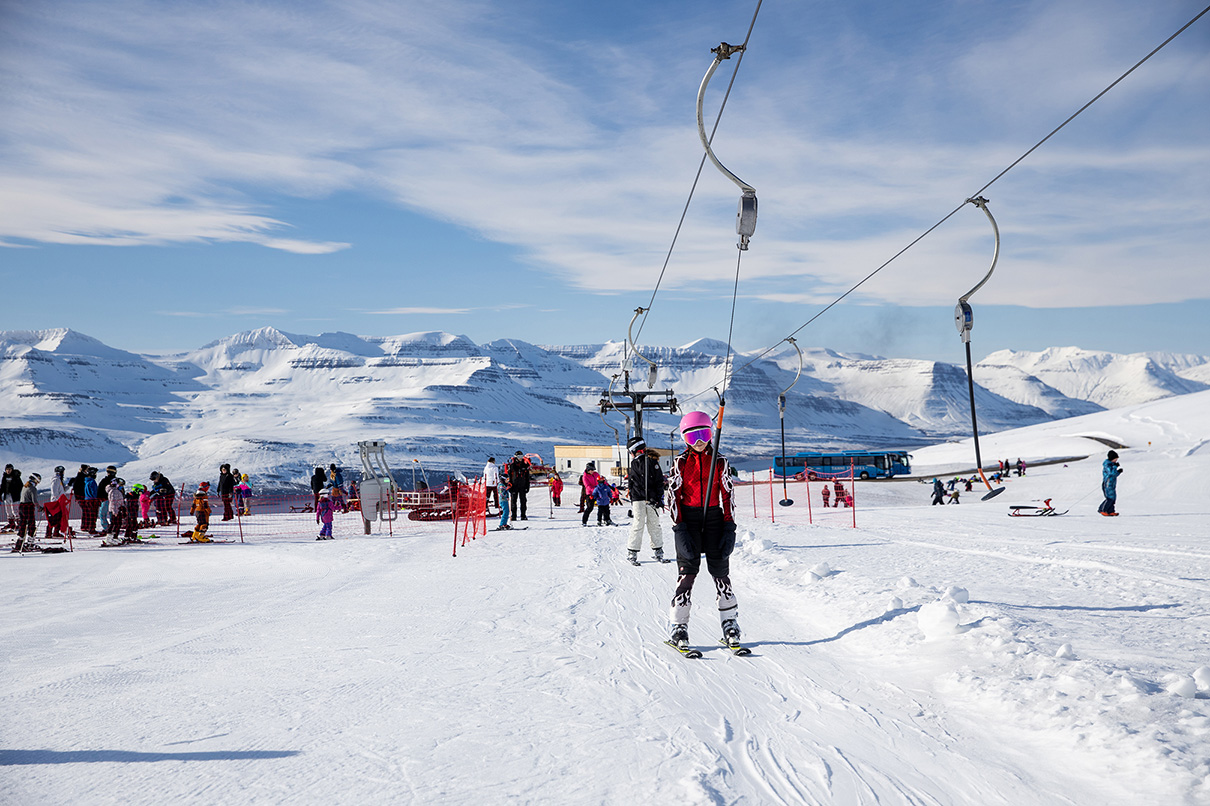3.3 Outdoor Recreation and Sports
In East Iceland, facilities for both outdoor and indoor fitness activities will be diverse, with good accessibility ensured to areas offering outdoor recreation opportunities close to nature. There will be many and varied options for sports participation. Sports events will be strengthened, and wellness projects will increase.

Policy on General Outdoor Recreation Areas
Æ.1. Diverse Outdoor Fitness Facilities in Urban Areas and Surroundings.
Efforts will be made to plan and develop diverse, green, and well-equipped recreational areas of different sizes and types. These areas will be connected by walking and cycling paths and offer opportunities for exercise, play, social interaction, and rejuvenation for different age and ability groups.
Æ.2. Good Accessibility to Rural Areas for Outdoor Recreation Close to Nature.
Efforts will be made to improve access to areas suitable for general outdoor recreation, such as by creating parking spaces, paths, and rest areas in forests, and planning routes and destinations.
Æ.3. Increasing Opportunities for Beach and Water Sports:
Efforts will be made to improve facilities for sailing, sea fishing, kayaking, and other water sports.
Explore the product development opportunities offered by the coastline.
Promote the development of facilities for sea swimming.
Æ.4. Maintaining and Strengthening Opportunities for Recreational Fishing on Land and Sea:
East Iceland will continue to be marketed as a hunter’s paradise, with exemplary conditions for hunting and fishing.
Reindeer and reindeer hunting will remain a significant part of the region’s external image.
Highlight opportunities for sea fishing in the fjords.

Explanations for the Policy on General Recreational Areas
There are countless opportunities in East Iceland for engaging in outdoor activities in a natural environment, which have particularly nourishing effects on people. It is important to ensure good access for everyone to such areas, e.g., by creating parking spaces, pathways, and mapping out walking, running, and cycling routes of varying lengths and difficulty.24
Additionally, East Iceland offers exciting opportunities for various types of hunting sports, which require extensive outdoor activities in nature. East Iceland is the only region in the country where reindeer hunting is possible, with the hunting season occurring in August and early September. It is also possible to hunt geese, ptarmigan, and puffins, among others. The region has popular fishing rivers with good facilities, in addition to numerous trout fishing streams.
Most of the urban areas in the East Fjords developed around fishing, and most of them have good harbour facilities, which offer possibilities for various types of water sports, such as sailing and sea angling. The deep and often sheltered fjords of East Iceland should also be ideal for kayaking, paddleboarding, and sea swimming. These sports can attract a wide range of participants and do not necessarily require extensive or expensive facilities.
Over the years, there have been several attempts to develop kayaking and other boating sports along the coast, and although such tourism has not taken root, these activities remain popular among the public. In several places, there is a strong tradition of club activities, e.g., related to kayaking, where facilities have been developed to store equipment and even borrow it.
Every year, popular sporting events that attract people from all over the country are held in East Iceland. For example, the Urriðavatn Swim, held in connection with the Land Guardian Challenge by the Iceland Touring Association, the Dyrfjalla Run in Borgarfjörður Eystri, and the hiking week “On Your Feet Fjarðabyggð,” which is held in June and July each year. Additionally, there is the Winter Running Series by UMF Þristar in Egilsstaðir. In March, the East Iceland Freeride Festival is held in Fjarðabyggð, and in the spring, various hiking and mountain skiing courses and trips are available in the region. Further development in this direction is likely given the increasing public interest in fitness projects of all kinds and the diversity that the landscape of East Iceland offers.
Besides utilizing the dramatic nature of East Iceland for outdoor activities, it is important that urban areas have diverse and high-quality recreational spaces that encourage physical activity and social interaction for different age groups.25 For example, outdoor exercise areas could be placed along walking paths.
Well-designed and interesting playgrounds within urban areas attract both young and old and encourage families to spend time outdoors. They can become venues for interaction between parents and children. It is important to ensure good access to such playgrounds within residential areas.26

Policy on Recreational and Specialized Sports Areas
Ö.1 Facilities for General Sports Activities and Competitive Sports should be Diverse and Exemplary
Emphasis will be placed on ensuring that all major sports can be practiced and that participation in competitions is possible.
Support will be given to the participation of children and youth in sports activities, and public transportation to sports facilities will be ensured.
The costly development of specialized competition and training facilities will be approached in a way that benefits residents of the entire area.
Emphasis will be placed on professionalism in coaching and management of sports activities. Support will be provided for the activities of sports clubs.
Ö.2 Special Attention to the Development of Areas for Winter Sports for Residents and Visitors
Continued efforts will be made to develop good facilities for skiing and to ensure access for both residents and tourists.
Efforts will be made to improve opportunities for cross-country skiing in and around urban areas.
Possibilities for developing alpine skiing will be explored.
Opportunities offered by areas best suited for snowmobiling, for both residents and tourists, will be mapped.
Ö.3 Strengthening Sports Competitions and Increasing Various Fitness Projects
Sports facilities at selected locations and for selected sports will be improved to meet the requirements for hosting competitions.
Support will be given to and participation encouraged in fitness projects that utilize the facilities and recreational areas of East Iceland.

Explanations for the Policy on General Outdoor Recreation Areas
East Iceland offers countless opportunities for outdoor activities in natural environments, which have particularly nourishing effects on people. It is essential to ensure good accessibility for all to such areas, for example by creating parking spaces, paths, and mapping out walking, running, and cycling routes of varying lengths and difficulties.
In addition to good access to natural environments, there are various organized outdoor recreation and sports areas in East Iceland. Swimming pools are in most towns in the region. Vök Baths is a popular bathing spot with hot pools in and around Lake Urriðavatn, and there are natural hot springs in Fljótsdalur.
There are ski areas in Oddsskarð between Eskifjörður and Norðfjörður and in Stafdal between Seyðisfjörður and Egilsstaðir. The new Norðfjörður Tunnel and the upcoming Fjarðarheiði Tunnel call for a redefinition of the roads to these areas, and it is necessary to respond to this to ensure adequate access to the areas. There are no chairlifts in these ski areas, but opportunities for further development could attract more visitors and for a longer period of the year. Abroad, in Hlíðarfjall in Akureyri and in Skálafell in Mosfellsdalur, chairlifts are open in the summer for hikers and cyclists. There are various opportunities for hikers and mountain skiers, as well as snowmobilers, near the ski areas and in other places in East Iceland.
Golf is popular all over the country as it is suitable for people of all ages and thus an excellent family sport. There are six 9-hole golf courses in East Iceland; in Eskifjörður, Neskaupstaður, Reyðarfjörður, Seyðisfjörður, Vopnafjörður, and Fellabær. Disc golf has gained great popularity in recent years as a sport that does not cost much and can be enjoyed by most people. There are already several disc golf courses in East Iceland.
Children’s and youth sports are especially important for fostering community spirit and cohesion in small communities where coaches, families, and relatives have the opportunity to meet and interact. Strong sports activities also play an important role in public health and prevention for the future and this applies not only to competitive sports but also to amateur sports.<sup>27</sup> Training sessions for parents can be offered at the same time as children’s sports training, encouraging increased physical activity.
Sports halls and mini-pitches are in most of the urban centres in East Iceland, providing facilities for a variety of sports activities. Municipalities should ensure that there are opportunities for further development of sports facilities and good access to the facilities that already exist. It may be necessary to integrate public transport with leisure travel and ensure good walking and cycling connections to sports halls.<sup>28</sup>
Vilhjálmsvöllur in Egilsstaðir is the only athletics track in East Iceland that meets the requirements for hosting competitions. Fjarðabyggðarhöllin in Reyðarfjörður is the only full-size football hall in East Iceland with a regulation-sized pitch. Recently, a specialized facility for group gymnastics training was established in Egilsstaðir.
There is an equestrian hall and outdoor area at Iðavellir near Egilsstaðir and at Kirkjubólseyrar in Norðfjörður. The former is operated by the equestrian club Freyfaxi and the latter by the equestrian club Blær.<sup>29</sup>
There are shooting sports facilities in Reyðarfjörður and at Þuríðarstaðir in Fljótsdalshérað.

